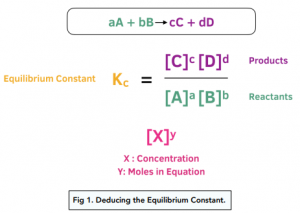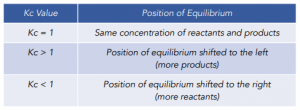Calculations with Equilibrium Constants (A-Level Chemistry)
Calculations with Equilibrium Constants
Equilibrium Constant
The Equilibrium Constant Kc
After a while of a reversible reaction being underway, a state of equilibrium is reached, with the concentrations of reactants (A and B) and products (C and D) changing not much thereafter. These concentrations are called the equilibrium concentrations.
We can calculate the equilibrium concentration by finding the equilibrium constant, which is the ratio of the concentration of products to the concentration of reactants.
The equilibrium constant, Kc can be deduced for a reversible reaction by using the following expression:

The magnitude of Kc can be used to estimate the position of equilibrium in a reaction:

Homogenous Reactions
The equilibrium constant is only for homogenous reactions.
Homogenous reactions involve reactants and products which are in the same phase – e.g. they are all in solution, or are all gaseous.
Heterogenous Reactions
Heterogenous reactions involve reactants and products in different phases – e.g. some are solid, some are liquid.
If you have a heterogenous mixture, you can still find out the equilibriumconstant:
- For a reaction involving solids and gases, you can calculate Kc, but ignore the concentration of solids.
- For a reaction involving solids and liquids, you can calculate Kc, but ignore the concentration of solids.
- For a reaction involving liquids and gases, you cannot calculate Kc, but instead calculate Kp (which we will learn about in later chapters).
Kc Calculations
Calculating a Value for the Equilibrium Constant Kc
If you know the values of the molar concentration of each of the substances at equilibrium, you can calculate the value of Kc by substituting the concentrations into the expression above. You will need to work out the units yourself as these will vary per calculation.
Practice Question: What is the value for Kc of the reaction with the equation:
H2 (g) + Cl2 (g) ⇌ 2HCl (g)? The equilibrium concentrations are: [H2] = 0.67 mol dm–3, [Cl2) = 0.83 mol dm–3 and [HCl] = 0.33 mol dm–3.
Method:
1. Write an expression for Kc using the reversible reaction equation.

2. Substitute the molar equilibrium concentrations into the equation and calculate the value of Kc.

3. Finally calculate the units of the value for Kc by just substituting the equation with the units without putting the numbers in.

Therefore the units cancel out therefore there are no units for Kc in this example.
Finding the Equilibrium Concentrations
Sometimes you will have to calculate the equilibrium concentrations in a reaction before calculating the value of Kc.
Practice Question: In an experiment, 0.18398 moles of carbon monoxide is hydrogenated with 0.22046 moles of hydrogen. The reaction takes place in a vessel of 1.00 dm3. The equilibrium mixture contains 0.05176 moles of methanol. The equation is: CO(g) + 2H2(g) ⇌ CH3OH(g). What is the value of Kc including units?
Method:
1. Calculate the number of moles of CO and H2 at equilibrium.
We know that CO and CH3OH are in a 1:1 molar ratio. This means that for every 1 mole of CO that reacts, 1 mole of CH3OH is produced.
Therefore as 0.051716 moles of CH3OH is produced, the number of moles of CO would have reduced by 0.0 51716 moles.
Number of moles of CO at equilibrium = 0.18398 – 0.051716 = 0.132264 moles
We also know that H2 and CH3OH are in a 2:1 molar ratio. For every 1 moles of CH3OH produced, 2 moles of H2 are used up.
This means that as 0.051716 moles of CH3OH is produced, the number of moles of H2 must have reduced by 0.051716 moles multiplied by 2:
Number of moles of H2 at equilibrium 0.22046 – (0.051716 x 2) = 0.117028 moles

2. Calculate the molar concentrations by dividing each number of moles by the total volume of the vessel.
Here the equilibrium molar concentrations are the same as the equilibrium number of moles of each of the substances as the volume of the vessel is 1.00 dm3.
When you divide each of the equilibrium number of moles by 1.00, you get the same value for the concentration.
The molar concentrations at equilibrium are therefore:
[ CO ] = 0.132264 mol dm–3
[ H2 ] = 0.117028 mol dm–3
[ CH3OH ] = 0.051716 mol dm–3
3. Write an expression for Kc and substitute the concentrations into the Kc expression to calculate its value.

4. Finally work out the units.

Therefore the units of Kc = mol dm–6
The value of Kc is 28.6 mol dm–6
Using Kc to find the Equilibrium Concentrations
If you know the value of Kc, you can calculate the concentrations of substances in a reaction at equilibrium.
Practice Question: In an experiment that was allowed to reach equilibrium, 2.5 moldm–3 of H2O and 3.0 mol dm–3 of CO are allowed to reach equilibrium. If the value of Kc is 4.5 at 800K what are the equilibrium concentrations of all species in the equation: CO(g) + H2O(g) ⇌ H2 (g) + CO2 (g) ?
Method:
1. First of all write an expression for Kc using the reversible equation given.

2. Substitute all the known equilibrium concentrations into the Kc expression.

3. Finally rearrange the equation to find the unknown equilibrium concentrations.
[H2] [CO2] = 4.5 x 7.5 = 33.75
We know that the molar ratio of [H2] : [CO2] is 1:1.
Therefore as [H2] = [CO2] = √33.75 = 5.81 mol dm–3 (to 3 significant figures).
Therefore the equilibrium concentrations of all species in the equation are:
[H2] = 5.81 mol dm–3
[CO2] = 5.81 mol dm–3
[CO] = 3.0 mol dm–3
[H2O] = 2.5 mol dm–3
Effect of Changes in Temperature, Concentration and Pressure on Kc
Temperature and Kc
The value of Kc will change if the temperature is changed as the temperature change will affect the direction in which the reaction goes. Earlier we learned that an increase in temperature favours the reaction in the endothermic reaction and a decrease in temperature favours the reaction in the exothermic reaction.
If you change the temperature of a reaction, the change in Kc depends on what happens:
Increase in Product = ↑Kc
If we write an expression for Kc, remember that the concentrations of the products are at the top (numerator) and the concentrations of the reactants are at the bottom (denominator). This means that if a temperature change increases the amount of product that is formed, the value of the numerator will increase and therefore the value of Kc will be higher.
Decrease in Product = ↓Kc
If a temperature change decreases the amount of product that is formed, the value of the numerator will decrease and therefore the value of Kc will be lower.
Changed Concentration = Unchanged Kc
If the concentration of either the reactants or products is changed Kc is not changed.
Catalyst = Unchanged Kc
Using a catalyst in the reaction does not affect the value of Kc. A catalyst speeds up the reaction in both directions so that equilibrium is reached faster
FAQs
An equilibrium constant (Kc) is a value that represents the relative concentrations of reactants and products in a chemical reaction at equilibrium.
To find the equilibrium constant (Kc) for a reversible chemical reaction in A-level Chemistry, you need to know the balanced chemical equation and the concentrations of the reactants and products at equilibrium.
The equilibrium constant is calculated by dividing the product of the equilibrium concentrations of the products by the product of the equilibrium concentrations of the reactants, with each concentration raised to the power of its stoichiometric coefficient in the balanced chemical equation.
The general formula for the equilibrium constant is:
Kc = [C]^c [D]^d / [A]^a [B]^b
Where [A], [B], [C], and [D] are the equilibrium concentrations of the reactants and products, and a, b, c, and d are the stoichiometric coefficients of the balanced chemical equation.
The value of Kc provides information about the position of a chemical reaction. If Kc is greater than 1, the reaction will shift towards the side with more products. If Kc is less than 1, the reaction will shift towards the side with more reactants. If Kc is equal to 1, the reaction is at equilibrium.
Changes in the concentration of reactants or products will affect the value of Kc, which in turn will determine the direction and magnitude of the shift in the chemical reaction. By rearranging the equation for Kc and using changes in concentration, you can determine the effect of changes in concentration on the reaction.
No, Kc does not directly provide information about the rate of a reaction. It only provides information about the position of the reaction at equilibrium. To determine the rate of a reaction, you would need to use other methods, such as the rate law or reaction rate constants.
The value of Kc can be affected by temperature because it is a measure of the balance of a chemical reaction at a given temperature. An increase in temperature can shift the reaction towards the side with more energy and change the value of Kc.
Kc and Kp are both equilibrium constants, but they are used in different situations. Kc is used for reactions in aqueous solution and involves the concentration of ions and molecules, while Kp is used for reactions in the gas phase and involves the pressure of gases.
Yes, you can use Kc to determine Kp by converting the concentrations in the expression for Kc to partial pressures using the ideal gas law.
Yes, you can use Kc to determine the changes in Gibbs free energy (ΔG) for a reaction by using the relationship between ΔG and Kc, which is expressed by the equation ΔG = -RTlnKc, where R is the gas constant and T is the temperature in Kelvin.
You can use the value of Kc and the initial concentrations of the reactants to determine the concentrations of the products and reactants at equilibrium by setting up and solving an equation that balances the reaction and the value of Kc. This method is known as the Equilibrium Constant Expression (Kc) method.






Still got a question? Leave a comment
Leave a comment